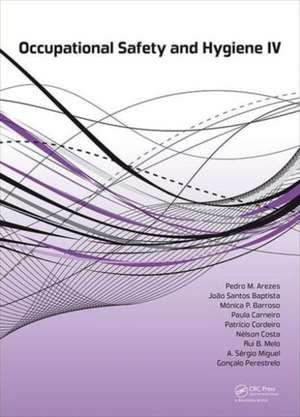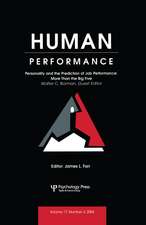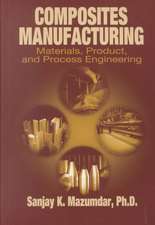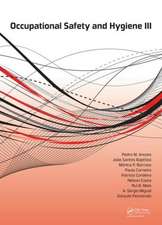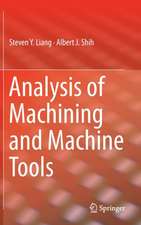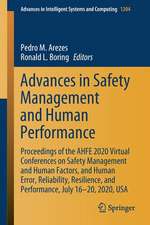Occupational Safety and Hygiene IV
Editat de Pedro M. Arezes, João Santos Baptista, Monica P. Barroso, Paula Carneiro, Patrício Cordeiro, Nelson Costa, Rui B. Melo, A. Sergio Miguel, Gonçalo Perestreloen Limba Engleză Hardback – 5 apr 2016
- Occupational Safety
- Risk Assessment
- Ergonomics
- Management Systems
- Physical Environment
- Construction Safety, and
- Human Factors
This compilation of papers in the domain of occupational safety and hygiene is mainly based on research works carried out at universities and other research institutions, and on practical studies developed by Occupational Safety & Health (OSH) practitioners within their companies. Accordingly, this book will be helpful to get acquainted with the state-of-the-art of the research within the mentioned domains, as well as with some practical tools and approaches that are currently used by OSH professionals in a global context.
Preț: 1223.43 lei
Preț vechi: 1638.43 lei
-25% Nou
Puncte Express: 1835
Preț estimativ în valută:
234.11€ • 245.04$ • 194.85£
234.11€ • 245.04$ • 194.85£
Carte tipărită la comandă
Livrare economică 29 martie-12 aprilie
Preluare comenzi: 021 569.72.76
Specificații
ISBN-13: 9781138029422
ISBN-10: 1138029424
Pagini: 636
Dimensiuni: 174 x 246 mm
Greutate: 1.22 kg
Ediția:1
Editura: CRC Press
Colecția CRC Press
ISBN-10: 1138029424
Pagini: 636
Dimensiuni: 174 x 246 mm
Greutate: 1.22 kg
Ediția:1
Editura: CRC Press
Colecția CRC Press
Public țintă
Postgraduate and ProfessionalNotă biografică
Pedro Arezes is a full professor on Human Factors Engineering at the School of Engineering of the University of Minho (UMinho), in Portugal. He is also a visiting scholar at MIT and Harvard University, in the USA. He coordinates the Human Engineering research group at the UMinho, and his research interests are in the domain of Safety, Human Factors Engineering and Ergonomics.
Dr. Arezes is also the current National Director of the MIT Portugal Program, a government strategic partnership between Portuguese Universities, the Massachusetts Institute of Technology and partners from industry and government. He was the supervisor of more than 70 MSc. theses at several universities,11 completed PhD theses, and the host supervisor of some post-doc projects with colleagues coming from different countries, such as Brazil, Poland, and Turkey. He is the (co-)author of more than 50 papers published in international peer-reviewed journals, author/editor of more than 40 books published internationally, as well as the (co-)author of more than 250 papers published in international conference proceedings with peer-review.
Dr. Arezes is also the current National Director of the MIT Portugal Program, a government strategic partnership between Portuguese Universities, the Massachusetts Institute of Technology and partners from industry and government. He was the supervisor of more than 70 MSc. theses at several universities,11 completed PhD theses, and the host supervisor of some post-doc projects with colleagues coming from different countries, such as Brazil, Poland, and Turkey. He is the (co-)author of more than 50 papers published in international peer-reviewed journals, author/editor of more than 40 books published internationally, as well as the (co-)author of more than 250 papers published in international conference proceedings with peer-review.
Cuprins
Foreword, Occupational exposure assessment to particles with task-based approach, Trends of Volatile Organic Compounds in different indoor microenvironments: A review, Climate changes influence in occupational exposure to fungi and mycotoxins, Changes of air temperature and its effects on student’s health, Biomechanical analysis of the manual handling of fertilizers in silvicultural operations, in mountainous regions, Exposure to emissions from cleaning products in primary schools: A test chamber study, Analysis of overload in the musculoskeletal system of women developing repetitive tasks in fluid filling process in chemical industry, Communication strategies in Occupational Safety and Health training for foreign university students: A case study, The Portuguese anthropometric database comparison, Human systems engineering approach for safety and risk management of complex systems design, Assessment of gaseous pollutants in a preschool environment, Influence of psychosocial factors in the pain symptoms, Development of ergonomic sofas for labor rest areas, Performance evaluation in teaching environments on climate change, Firefighter’s occupational exposure to PM2.5 and Polycyclic Aromatic Hydrocarbons, Influence of temperatures’ variation on students’ productivity, The workaholism as an obstacle to safety and well-being in the workplace, Chemical risk in the footwear industry, The noise exposure of workers of the footwear industry, Air quality in teaching lab: Perception of students and analysis of Particulate Matter, Perceptive assessment in viability of job rotation at a footwear industry, Risk assessment in a chemical laboratory, Shaping a work safety by use of the 5S methodology, Comfort requirements assessment on indoor environmental quality in hospital’s ICU, Noise perception of male motorcycle police officers in João Pessoa, Brazil, Work environmental conditions (noise and vibrations) in a professional conservatory of dance in Spain, Good management practices of the waste and of the health and the safety conditions in the constructive process: Sustainability, social responsibility and ethical business activity, Organizational culture—decisive factor for safety and health at work in construction companies, Verification of project requirements that influence workers’ health in the development of industrial equipment, Prevalence of symptoms of musculoskeletal injuries related to the work of caregiver—case study of a social institution, “Safety and health” as a criterion in the choice of tunnelling method, Construction workers’ training: Contributions to a more effective prevention culture, Brazilian performance standard—NBR 15.575: Safety in use and operation of housing buildings, Heavy metal exposure in landfill leachate treatment facilities, Design for Maintenance guidelines: Safety height work, Analysis of the evolution and impact of electrical occupational accidents in Spain, BIM as a support for the design process with fire safety regulations, Musculoskeletal pain and physical workload among dental students, The outcomes of shift work in the context of psychosocial functioning—sex aspects, Information technology applied to the safety management, Consequences of occupational accidents due to direct and indirect electrical contact, An activity of “acceptable risk”, the one of the Occupational Health and Safety professionals?, Epidemiological analysis of accidents at work in Brazil based on the National Household Health Survey, The impact of patient’s suicide on health care professionals, Analysis of the chemical hazards present in the sugar production: A comparative study between the crystal and demerara sugar, Impact of the work process on power grip strength: A practical case, Impact of exposures to environmental factors on sense of balance stimulation, Working conditions in the ceramic industry: Assessment of the heat exposure with the Predicted Heat Strain (PHS) index, Student Occupational Health and Safety in technological education, Working postures of spot welding machine operators, Shift work: Impact on sleep, family and social life, and satisfaction with work schedule, Impact of fatigue on selected psychomotor characteristics: A practical example (Dufour Cross-Shaped Apparatus), Application of the TRIZ method in design oriented to the various needs of people with disabilities, Numerical modeling of the physical parameters of the thermal environment in industrial contexts, Dynamics of skin surface temperature in the hand after computer work: A review, Safety lifting—equipment’s, Occupational stress in Portuguese physiotherapists, Analysis of work disability in the workers of a central hospital—the impact of the Musculoskeletal Injury, Injuries treatment body posture monitoring system, Cardiovascular parameters of students subjected to temperature changes, Industrial wastes: Analysis of parameters addressed by the Regulatory Norm 25 in a tannery located in southwest of Minas Gerais, Vehicle thermal comfort: Generalized Linear Modeling to the case of the military police of Paraíba—Brazil, On the use of accident indicators in risk-based management of occupational safety and health: Example of application to Spain, Inherent risk management activities disassemble the rocks with explosives, Association of hand size with usability assessment parameters of a standard handheld computer pointing device, Life quality and health of women workers from family agriculture, Analysis of safety culture on the example of selected Polish production enterprises, Analysis of registration and notification of circumstances in official investigation reports on occupational accidents, Effectiveness of an intervention in small and medium enterprises by safety assessors with enforcement ability, Exploring marine accident causation: A case study, Evaluation of indoor air quality in kindergartens—case study, Evaluation of exposure to particulate poultry farms, The air fresheners influence on the quality of the air—cross-sectional study, Characterization of the thermal environment of the metal industry workers (with foundry), Empowerment for women riverside farmers: Workplace health promotion at Northeast of Brazil, Causes of failure in corrective maintenance—a case study, Work, health and gender differences in Portuguese physiotherapists, Diffusion of integrated Occupational Health and Safety Management Systems, The influence of the quality of the cooking oil from the frying process in food safety—case study in the catering industry, Perception of occupational risk exposure to Xylene, Ethylbenzene and Toluene by workers of furniture industry, Use of effectiveness and efficiency concepts in occupational safety management on motorways: A systematic review, Cross-sectional study of assessment of thermal comfort levels in aviary workers, Noise exposure of the students from Colleges of Health Technology of Portugal, A view of occupational risk prevention by researchers in the Nanosciences, but not exposed to nanomaterials, Schoolbag weight and the postural and psychophysical changes in young students: A pilot study, Portuguese economic situation of the influence on the labour accident, Work-Related Musculoskeletal Disorders of the upper limbs in an auto components company, Ergonomic in the callcenter context: Protocol of the Ergonomic Work Analysis of the Telemarketing, Relationship between production cycles and noise patterns in loading and transport operations in quarries, Assessing Work-Related Upper Limb Disorders with infrared images and mouse repetitive challenge, Measurements of indoor radon and total gamma dose rate in Portuguese thermal spas, Evaluation of a public intervention in high injury rate enterprises, In-vehicle auxiliary driving equipment systems—a user interaction for safety review, Analysis of potential risks for the user in equipment and workstations, Survey of the knowledge and correct use of Scrub Suits, Gowns and Clean Air Suits in Portuguese hospitals, Thermal and health conditions in smart learning environments, Safety coordinator specific on a road construction, Risk assessment and control measures from exposure to Electromagnetic Fields in mobile communications, The working platforms and safety, Self-Rated Health and their relationships with work in the perspective of the women Brazilian Northeast, Ergonomic design of store shelving for the elderly applying universal design with a focus on health and safety, Relationship between BMI, regular physical activity and musculoskeletal back pain indication in college students, Management Systems for Health and Safety and OSHA 18001 certification in Brazil, Asbestos application in construction, Clam’s production floating platform, Health care staff perception of noise in Neonatal Intensive Care Units: A questionnaire survey from NeoNoise project, Comfort lightning and energy efficiency in open space offices, Physical exertion in military during heat stress conditions—preliminary results, Analysis of thermal environment at a workplace: A case study in a jewelry shop, Safety: Factor of business through the adoption of NTEP in a civil construction company—case study, Occupational Health and Safety management system: A case study in a waste company, A method for evaluating aircraft used for visual flight rules VFR: Reliability, performance and security, Job accommodation of people with disabilities in the construction industry: Analysis of production and absence, Psychosocial risks at the Portuguese contact centres, Author index
Descriere
This book will be helpful to get acquainted with the state-of-the-art in occupational health and safety research, as well as with some practical tools and approaches that are currently used by OSH-professionals in a global context.
